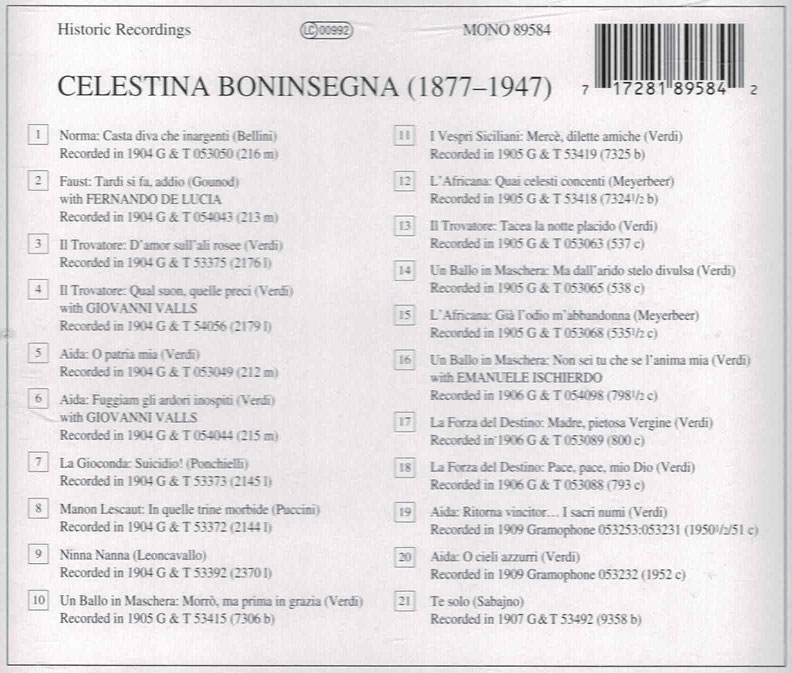Logowanie
Mikołaj - ten to ma gest!
Elton John, The Mamas & The Papas, Cat Stevens, Rod Stewart, Bobbie Gentry, Stevie Wonder, Engelbert Humperdinck
Memory Lane
Edycja Numerowana - 1000 egzemplarzy w skali światowej
RACHMANINOV, Eiji Oue, Minnesota Orchestra
Symphonic Dances / Vocalise
Best Recordings of 2001!!! NAJCZĘŚCIEJ KUPOWANA PŁYTA Z RR!
Karnawał czas zacząć!
Music of Love - Hi-Fi Latin Rhythms
Samba : Music of Celebration
AUDIOPHILE 24BIT RECORDING AND MASTERING
CHOPIN, LISZT, DEBUSSY, DVORAK, Gerhard Oppitz
Dances romantiques - A fantastic Notturno
Wzorcowa jakość audiofilska z Clearaudio
Winylowy niezbędnik
ClearAudio
Double Matrix Professional - Sonic
najbardziej inteligentna i skuteczna pralka do płyt winylowych wszelkiego typu - całkowicie automatyczna
BELLINI, GOUNOD, VERDI, PUCCINI
Celestina Boninsegna

- BELLINI
- GOUNOD
- VERDI
- PUCCINI
Lebendige Vergangenheit
Der Vorname Celestina ("die Himmlische") könnte bei dieser mit einer wahrhaften "vox coelestis" begabten Sängerin als symbolhaft aufgefaßt werden. Trotz des hohen Alters der Aufnahmen ist uns die unvergleichliche Schönheit dieser in allen Lagen vollkommen ausgeglichenen Stimme bewahrt geblieben. Am 17. Jänner 1901 wirkte sie bei der Uraufführung von Mascagnis Oper "Le maschere" (Teatro Costanzi, Rom) unter der persönlichen Leitung des Komponisten mit. Celestina Boninsegna war überhaupt eine Künstlerin, die im zeitgenössischen Opern schaffen eine wesentliche Rolle spielte. Abgesehen davon vermochte sie sich auch als Interpretin der großen Belcanto-Partien der älteren italienischen Oper auszuzeichnen. Zu ihren Glanzpartien zählten unter anderem die Aida und die Leonore in Verdis "Die Macht des Schicksals". Denkwürdige Bühnenleistungen der Sängerin waren unter anderem ihre Verkörperung der Norma in Bellinis Oper (Triest 1909), die Margarethe von Valois in Meyerbeers "Hugenotten", weiterhin die Hauptrollen in Ponchiellis "La Gioconda", Mascagnis "Cavalleria rusticana", Verdis "Troubadour", "Ernani", "Ein Maskenball", sowie die Salome von Richard Strauss.Noch im Vollbesitz ihrer gesanglichen Fähigkeiten zog sie sich 1920 von ihrer Bühnenlaufbahn zurück, und wirkte daraufhin längere Zeit am Konservatorium von Pesaro als Gesangslehrerin. Zu ihren Schülerinnen zählte die Sopranistin Margherita Grandi. Den letzten Abschnitt ihres Lebens verbrachte sie in Mailand. Celestina Boninsegna, dramatic soprano of the Golden Age of Opera, was born in Reggio Emilia, Italy, in 1877 and died in Milan in 1947. So noteworthy were her natural vocal gifts thaI when she made her debut at fifteen as Norina in Don Pasquale she won general praise despite the fact that her training was practically nil. Encouraged by public enthusiasm to pursue her career seriously, young Celestina enrolled in the Conservatory of Music in Pesaro. After her graduation, singing engagements were plentiful, and she was heard at La Scala and in opera hauses in many cities of Italy aside from those in London, in Madrid, and in Buenos Aires. In 1901, Boninsegna created the role of Rosaura in Mascagni's Le Maschere in Rome. By the time she had come to the United States to begin her 1906-7 season with the Metropolitan Opera, she was thoroughly familiar with many leading roles and most famous für her performances in Trovatore, Tosca, Mefistofele, Cavalleria Rusticana, and Aida. It was unfortunate that competition at the Met in the 1906- 7 season was very keen. Boninsegna did not have the physical allure of Geraldine Farrar who made her debut that year and charmed audiences in Romeo and Juliet, Damnation of Faust, Faust, Madame Butterfly (debut), and La Boheme. She could not match the sales appeal of the lovely Lina Cavalieri who thaI year was a major attraction in the first American performance of Giordano's Fedora and in the first Metropolitan performance ofPuccini's Manon Lescaut, as weil as lending her attractive stage presence to La Boheme and Pagliacci. As a newcomer, Boninsegna stood small chance of snatching dramatic roles from Emma Eames, who was firmly entrenched with the public and with the ruling interests at the Met, or from Olive Fremstad, then at the height of her powers in Carmen, Wagnerian roles, Meyerbeer's Africaine, and in the sensational Salome of Strauss. It is small wonder thaI during her year at the Met, Boninsegna was given small opportunity to present her talents in the most favorable light. In the course of the entire year, she had only three opportunities to sing: the first, on December 21, 1906 when she appeared as Aida with Caruso, Stracciari, and Plancon: on January 13, 1907 when she sang an aria from Cavalleria Rusticana at a concert, and on February 16, 1907 when she sang the role of Santuzza in Cavalleria Rusticana with Dippel. Her career on records gives a rar truer picture of her stature and versatility. Her earliest recordings were on Pathe discs in 1903, and her latest were issued in 1917.





























